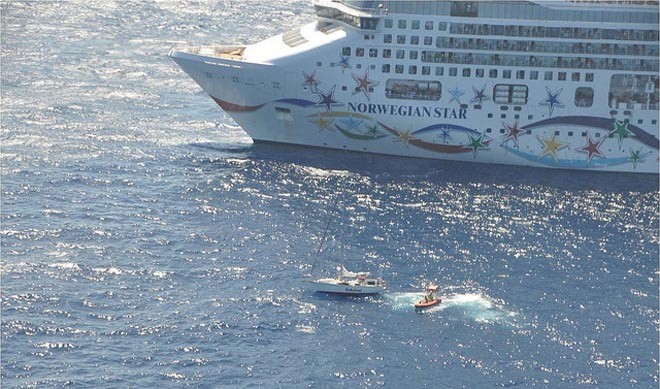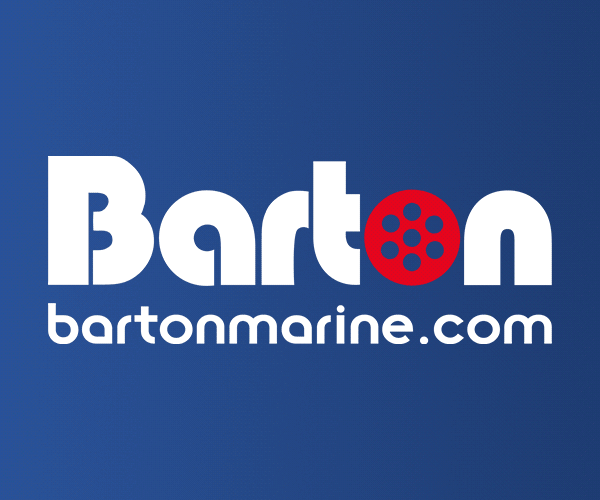Another rescue by AMVER ship Northern Star - thank you AMVER!
by Nancy Knudsen on 11 Mar 2012

Hokulani and Northern Star - photo by USCG, AMVER1958 SW
One of the main positive reasons for studying incidents at sea and rescues is to discover what can be learned vicariously, but the following story of a rescue has an equally important reason - the recognition of the vital global role that AMVER (Automated Mutual-Assistance Vessel Rescue System) plays in modern rescues. Read this latest anecdote first:
The Amver participating cruise ship, Norwegian Star, rescued two sailors from their disabled sailboat 55 miles northwest of Pinar Del Rio, Cuba on Saturday, March 3, 2012. U.S. Coast Guard rescue authorities in Miami received an Emergency Position Indicating Radio Beacon (EPIRB) alert for the 38 foot sailboat- Hokulani.
The Coast Guard, using an Amver surface picture, determined the Norwegian Star was only 30 miles away from the distress location and diverted them to assist. They also launched an Ocean Sentry aircraft to assist in the search.
The sailboat was severely damaged by rough seas and the crew was worried they would not make it to port. 'We have been dragging our rogue [anchor] for 18 hours,' a survivor reported to the Coast Guard, 'I don’t know we can make it.'
The 965 foot cruise ship arrived on scene and launched a small boat to recover the two sailors. Waves were 2 to 4 feet with winds gusting approximately 20 knots as the rescue boat came alongside the sailboat, blessedly calm weather for the rescue of the sailors.
The cruise ship was on its way from the Caribbean to Tampa when the incident occurred, and a passenger on the cruise ship took this video from the ninth floor balcony of her cabin:
Within four hours of the initial distress notification the sailors were safely aboard the Bahamian flagged cruise ship and headed to its next port, Tampa, Fla. The sailboat was marked as a hazard to navigation and left adrift. The sailors were uninjured.
The Norwegian Star enrolled in the Amver system on July 28, 2004 and has earned seven awards for participation.
The was not the first time the Norwegian Star has saved someone.
The cruise ship also rescued a sailor from a damaged sail boat in 2009 near Cabo San Lucas, Mexico.
Reporting, as we at Sail-World often are on world-wide rescues, it almost the norm rather than the exception that AMVER becomes involved at some point in the rescue. Sometimes they merely stand by to give wind cover until rescuing authorities arrive, but only too often they act as the rescuing party.
How does it work?
It is a computer-based system which identifies at any given second where the ships of volunteer shipping companies have their ships. This is then used worldwide by search and rescue authorities to arrange for assistance to persons in distress at sea.
With AMVER, rescue coordinators can identify participating ships in the area of distress and divert the best-suited ship or ships to respond. Participating in AMVER does not put ships under any additional obligation to assist in search and rescue efforts, beyond that which is required under international law.
Beginnings with the Titanic disaster:
The beginnings of the AMVER system were with the Titanic disaster in 1912. Ships passing within sight of the ill-fated passenger liner were unaware that it had hit an iceberg and was sinking. Upon later investigation, those who had seen the distress flares from the stricken ship admitted they thought they were merely part of the maiden voyage celebrations. This tragic information was the genesis of the seen necessity for a full time global emergency reporting system, but it was not to come into force until 1958, when AMVER was born.
Today:
Today, over 22,000 ships from hundreds of nations participate in Amver. An average of 4,000 ships are on the Amver plot each day and those numbers continue to increase. The Amver Center computer receives over 14,000 Amver messages a day.
Over 2,800 lives have been saved by Amver-participating ships since 2000. The success of Amver is directly related to the extraordinary cooperation of ships, companies, SAR authorities, communication service providers and governments in supporting this international humanitarian program to protect life and property at sea.
For the cruising sailors of the world, thank you AMVER.
On the way back from the Caribbean to Tampa on 3/3/12, the Norwegian cruise ship Star was called to rescue a sail boat from the Gulf of Mexico. I observed this rescue right from the ninth floor balcony of my cabin. I don't know what happened to the sail boat the Hokulani from Honolulu, Hawaii, but both passengers were rescued safely and their boat sent a drift.
If you want to link to this article then please use this URL: www.sailworldcruising.com/94756

